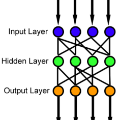Skeleton data is of low dimension. However, there is a trend of using very deep and complicated feedforward neural networks to model the skeleton sequence without considering the complexity in recent year. In this paper, a simple yet effective multi-scale semantics-guided neural network (MS-SGN) is proposed for skeleton-based action recognition. We explicitly introduce the high level semantics of joints (joint type and frame index) into the network to enhance the feature representation capability of joints. Moreover, a multi-scale strategy is proposed to be robust to the temporal scale variations. In addition, we exploit the relationship of joints hierarchically through two modules, i.e., a joint-level module for modeling the correlations of joints in the same frame and a frame-level module for modeling the temporal dependencies of frames. With an order of magnitude smaller model size than most previous methods, MSSGN achieves the state-of-the-art performance on the NTU60, NTU120, and SYSU datasets.
翻译:然而,有一种趋势是,在不考虑近年复杂程度的情况下,使用非常深而复杂的进料神经网络模拟骨架序列;本文件建议采用简单而有效的多尺度语义导神经网络(MS-SGN)进行基于骨架的行动识别;我们明确将联合体(联合型和框架指数)的高层次语义引入网络,以提高联合体的特征表现能力;此外,还提议采用一个多尺度战略,对时间尺度的变化起到强大的作用;此外,我们通过两个模块,即一个用于模拟同一框架内联合体相关性的联合级模块和一个用于模拟框架的时间依赖性的框架级模块,利用两个模块,即一个用于模拟同一框架内联合体相关性的联合级模块;一个用于模拟框架的时间依赖性的框架级模块;由于模型规模比大多数以往方法小得多,MSSGNTU60、NTU120和SUSU数据集的状态性能。




